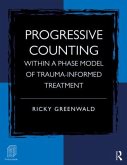Ricky Greenwald (Founder, Executive Director, and Ch Faculty Chair
EMDR Within a Phase Model of Trauma-Informed Treatment
Ricky Greenwald (Founder, Executive Director, and Ch Faculty Chair
EMDR Within a Phase Model of Trauma-Informed Treatment
- Broschiertes Buch
- Merkliste
- Auf die Merkliste
- Bewerten Bewerten
- Teilen
- Produkt teilen
- Produkterinnerung
- Produkterinnerung
A practical guide to learning and using EMDR.
Andere Kunden interessierten sich auch für
![Child Trauma Handbook Child Trauma Handbook]() Ricky GreenwaldChild Trauma Handbook60,99 €
Ricky GreenwaldChild Trauma Handbook60,99 €![Progressive Counting Within a Phase Model of Trauma-Informed Treatment Progressive Counting Within a Phase Model of Trauma-Informed Treatment]() Ricky Greenwald (Trauma Institute / Greenfiel Child Trauma InstituteProgressive Counting Within a Phase Model of Trauma-Informed Treatment71,99 €
Ricky Greenwald (Trauma Institute / Greenfiel Child Trauma InstituteProgressive Counting Within a Phase Model of Trauma-Informed Treatment71,99 €![EMDR Supervision EMDR Supervision]() Robin LogieEMDR Supervision31,99 €
Robin LogieEMDR Supervision31,99 €![Trauma-Attachment Tangle Trauma-Attachment Tangle]() Joan LovettTrauma-Attachment Tangle45,99 €
Joan LovettTrauma-Attachment Tangle45,99 €![Integrating Relational Psychoanalysis and EMDR Integrating Relational Psychoanalysis and EMDR]() Hemda AradIntegrating Relational Psychoanalysis and EMDR44,99 €
Hemda AradIntegrating Relational Psychoanalysis and EMDR44,99 €![EMDR and Creative Arts Therapies EMDR and Creative Arts Therapies]() EMDR and Creative Arts Therapies38,99 €
EMDR and Creative Arts Therapies38,99 €![EMDR in Family Systems EMDR in Family Systems]() Diana MilleEMDR in Family Systems39,99 €
Diana MilleEMDR in Family Systems39,99 €-
-
-
Produktdetails
- Produktdetails
- Verlag: Taylor & Francis Inc
- Seitenzahl: 272
- Erscheinungstermin: 8. August 2007
- Englisch
- Abmessung: 270mm x 210mm x 17mm
- Gewicht: 660g
- ISBN-13: 9780789032164
- ISBN-10: 0789032163
- Artikelnr.: 22954466
- Herstellerkennzeichnung
- Libri GmbH
- Europaallee 1
- 36244 Bad Hersfeld
- gpsr@libri.de
- Verlag: Taylor & Francis Inc
- Seitenzahl: 272
- Erscheinungstermin: 8. August 2007
- Englisch
- Abmessung: 270mm x 210mm x 17mm
- Gewicht: 660g
- ISBN-13: 9780789032164
- ISBN-10: 0789032163
- Artikelnr.: 22954466
- Herstellerkennzeichnung
- Libri GmbH
- Europaallee 1
- 36244 Bad Hersfeld
- gpsr@libri.de
Dr. Ricky Greenwald is a practicing clinical psychologist who has been working with children, teens, adults, and families since 1985. He is the Trauma Institute & Child Trauma Institute's founder, executive director, and chair of faculty.
SECTION I: TRAUMA-INFORMED TREATMENT AND EMDR
Chapter 1. Understanding Trauma
Why Trauma Matters
A Useful Definition of Trauma
What Makes an Event Traumatic?
The "Trauma Wall"
Resiliency and Vulnerability
Safety and Attachment
Posttraumatic Symptoms
Posttraumatic Symptoms over Time
A Note on Exercises/Activities in this Book
Exercise: Float-Back
Chapter 2. The Structure of Trauma Treatment
Meaning of Behavior
Selecting a Trauma Treatment Structure
Chapter 3. The Role of EMDR
Exposure
EMDR
Adaptive Information Processing Theory
The EMDR Protocol: The Eight Phases of Treatment
EMDR and Other Therapy Approaches
EMDR and the Fairy Tale Model
SECTION II: PHASE 1-CLIENT HISTORY AND TREATMENT PLANNING
Chapter 4. The Initial Interview: From "Hello" to History
Acculturation
Therapist Style
Introducing Treatment
The Rules
Individual Interview Strategies
How Much Should the Client Talk?
Obtaining More History While Focusing on Strengths
Chapter 5. Taking a Trauma History
Exercise: Take a Trauma/Loss History
Exercise Follow-Up Questions
Chapter 6. Trauma-Informed Case Formulation
Exercise: Do It Yourself
Chapter 7. Making a Treatment Contract
Motivation Enhancement
Finding the Princess
Treatment Planning and Contracting
Presenting the Treatment Plan
Obstacles to Following Through with the Contract
SECTION III: PHASE 2-CLIENT PREPARATION
Chapter 8. Safety and Stabilization
Avoiding High Risk
How Long Does Fence-Around Take?
Clients in Perpetual Crisis
Routines for Starting and Ending the Session
Fence-Around in the Session
Chapter 9. Resource Development and Installation
Introducing Eye Movements
Exercise: Practice Eye Movements
The Safe Place Visualization
Exercise: Safe Place
Safe Place Script
Problem Solving the Safe Place Intervention
Resource Development and Installation
Exercise: Resource Development and Installation
Exercise: Using the Resource in a Positive Template
Chapter 10. Self-Management Training
Self-Management of Anxiety Symptoms
Self-Control of Behavioral Choices
Choices Have Consequences
Exercise: Map Out a Problem
Chapter 11. Precautions for EMDR
Legal Issues
Medical Issues
Self-Control Issues
Secondary Gain
Timing
Dissociation
Dissociative Experiences Scale (DES) Information
Chapter 12. Final Preparations for EMDR
Reorient to the Treatment Plan
Target Order
Introducing EMDR
Accessing Resources
Exercise: Stop Means Stop and Safety Device
Stop Means Stop
Safety Device
Discussion
SECTION IV: PHASES 3-8-TRAUMA RESOLUTION
Chapter 13. Phase 3: Assessment, or "Setting Up the Target"
Exercise: Practice Target Setup
Discussion
Chapter 14. Phases 4 to 5: Desensitization and Installation
Preparing the Client
Doing the Eye Movements (EM)
Some Tips and Reminders
Exercise: Practice EMDR
Discussion
Chapter 15. Phases 6 to 7: Body Scan and Closure
Body Scan
Checks on Completion
Closure
Exercise: Container
Discussion Questions
Closure for All Sessions
Exercise: Practice EMDR
Chapter 16. Phase 8: Reevaluation and Consolidation of Gains
Reevaluation
Exercise: Reevaluation
Using the Float-Back
Exercise: Float Back and EMDR
Consolidation of Gains
Other Aspects of Daily Functioning
Anticipating and Preparing for Future Challenges
Ending Treatment
SECTION V: ADVANCED EMDR APPLICATIONS
Chapter 17. Problem Solving in an EMDR Session
When the Client Is Stuck
Other Challenges and Strategies
Chapter 1. Understanding Trauma
Why Trauma Matters
A Useful Definition of Trauma
What Makes an Event Traumatic?
The "Trauma Wall"
Resiliency and Vulnerability
Safety and Attachment
Posttraumatic Symptoms
Posttraumatic Symptoms over Time
A Note on Exercises/Activities in this Book
Exercise: Float-Back
Chapter 2. The Structure of Trauma Treatment
Meaning of Behavior
Selecting a Trauma Treatment Structure
Chapter 3. The Role of EMDR
Exposure
EMDR
Adaptive Information Processing Theory
The EMDR Protocol: The Eight Phases of Treatment
EMDR and Other Therapy Approaches
EMDR and the Fairy Tale Model
SECTION II: PHASE 1-CLIENT HISTORY AND TREATMENT PLANNING
Chapter 4. The Initial Interview: From "Hello" to History
Acculturation
Therapist Style
Introducing Treatment
The Rules
Individual Interview Strategies
How Much Should the Client Talk?
Obtaining More History While Focusing on Strengths
Chapter 5. Taking a Trauma History
Exercise: Take a Trauma/Loss History
Exercise Follow-Up Questions
Chapter 6. Trauma-Informed Case Formulation
Exercise: Do It Yourself
Chapter 7. Making a Treatment Contract
Motivation Enhancement
Finding the Princess
Treatment Planning and Contracting
Presenting the Treatment Plan
Obstacles to Following Through with the Contract
SECTION III: PHASE 2-CLIENT PREPARATION
Chapter 8. Safety and Stabilization
Avoiding High Risk
How Long Does Fence-Around Take?
Clients in Perpetual Crisis
Routines for Starting and Ending the Session
Fence-Around in the Session
Chapter 9. Resource Development and Installation
Introducing Eye Movements
Exercise: Practice Eye Movements
The Safe Place Visualization
Exercise: Safe Place
Safe Place Script
Problem Solving the Safe Place Intervention
Resource Development and Installation
Exercise: Resource Development and Installation
Exercise: Using the Resource in a Positive Template
Chapter 10. Self-Management Training
Self-Management of Anxiety Symptoms
Self-Control of Behavioral Choices
Choices Have Consequences
Exercise: Map Out a Problem
Chapter 11. Precautions for EMDR
Legal Issues
Medical Issues
Self-Control Issues
Secondary Gain
Timing
Dissociation
Dissociative Experiences Scale (DES) Information
Chapter 12. Final Preparations for EMDR
Reorient to the Treatment Plan
Target Order
Introducing EMDR
Accessing Resources
Exercise: Stop Means Stop and Safety Device
Stop Means Stop
Safety Device
Discussion
SECTION IV: PHASES 3-8-TRAUMA RESOLUTION
Chapter 13. Phase 3: Assessment, or "Setting Up the Target"
Exercise: Practice Target Setup
Discussion
Chapter 14. Phases 4 to 5: Desensitization and Installation
Preparing the Client
Doing the Eye Movements (EM)
Some Tips and Reminders
Exercise: Practice EMDR
Discussion
Chapter 15. Phases 6 to 7: Body Scan and Closure
Body Scan
Checks on Completion
Closure
Exercise: Container
Discussion Questions
Closure for All Sessions
Exercise: Practice EMDR
Chapter 16. Phase 8: Reevaluation and Consolidation of Gains
Reevaluation
Exercise: Reevaluation
Using the Float-Back
Exercise: Float Back and EMDR
Consolidation of Gains
Other Aspects of Daily Functioning
Anticipating and Preparing for Future Challenges
Ending Treatment
SECTION V: ADVANCED EMDR APPLICATIONS
Chapter 17. Problem Solving in an EMDR Session
When the Client Is Stuck
Other Challenges and Strategies
SECTION I: TRAUMA-INFORMED TREATMENT AND EMDR
Chapter 1. Understanding Trauma
Why Trauma Matters
A Useful Definition of Trauma
What Makes an Event Traumatic?
The "Trauma Wall"
Resiliency and Vulnerability
Safety and Attachment
Posttraumatic Symptoms
Posttraumatic Symptoms over Time
A Note on Exercises/Activities in this Book
Exercise: Float-Back
Chapter 2. The Structure of Trauma Treatment
Meaning of Behavior
Selecting a Trauma Treatment Structure
Chapter 3. The Role of EMDR
Exposure
EMDR
Adaptive Information Processing Theory
The EMDR Protocol: The Eight Phases of Treatment
EMDR and Other Therapy Approaches
EMDR and the Fairy Tale Model
SECTION II: PHASE 1-CLIENT HISTORY AND TREATMENT PLANNING
Chapter 4. The Initial Interview: From "Hello" to History
Acculturation
Therapist Style
Introducing Treatment
The Rules
Individual Interview Strategies
How Much Should the Client Talk?
Obtaining More History While Focusing on Strengths
Chapter 5. Taking a Trauma History
Exercise: Take a Trauma/Loss History
Exercise Follow-Up Questions
Chapter 6. Trauma-Informed Case Formulation
Exercise: Do It Yourself
Chapter 7. Making a Treatment Contract
Motivation Enhancement
Finding the Princess
Treatment Planning and Contracting
Presenting the Treatment Plan
Obstacles to Following Through with the Contract
SECTION III: PHASE 2-CLIENT PREPARATION
Chapter 8. Safety and Stabilization
Avoiding High Risk
How Long Does Fence-Around Take?
Clients in Perpetual Crisis
Routines for Starting and Ending the Session
Fence-Around in the Session
Chapter 9. Resource Development and Installation
Introducing Eye Movements
Exercise: Practice Eye Movements
The Safe Place Visualization
Exercise: Safe Place
Safe Place Script
Problem Solving the Safe Place Intervention
Resource Development and Installation
Exercise: Resource Development and Installation
Exercise: Using the Resource in a Positive Template
Chapter 10. Self-Management Training
Self-Management of Anxiety Symptoms
Self-Control of Behavioral Choices
Choices Have Consequences
Exercise: Map Out a Problem
Chapter 11. Precautions for EMDR
Legal Issues
Medical Issues
Self-Control Issues
Secondary Gain
Timing
Dissociation
Dissociative Experiences Scale (DES) Information
Chapter 12. Final Preparations for EMDR
Reorient to the Treatment Plan
Target Order
Introducing EMDR
Accessing Resources
Exercise: Stop Means Stop and Safety Device
Stop Means Stop
Safety Device
Discussion
SECTION IV: PHASES 3-8-TRAUMA RESOLUTION
Chapter 13. Phase 3: Assessment, or "Setting Up the Target"
Exercise: Practice Target Setup
Discussion
Chapter 14. Phases 4 to 5: Desensitization and Installation
Preparing the Client
Doing the Eye Movements (EM)
Some Tips and Reminders
Exercise: Practice EMDR
Discussion
Chapter 15. Phases 6 to 7: Body Scan and Closure
Body Scan
Checks on Completion
Closure
Exercise: Container
Discussion Questions
Closure for All Sessions
Exercise: Practice EMDR
Chapter 16. Phase 8: Reevaluation and Consolidation of Gains
Reevaluation
Exercise: Reevaluation
Using the Float-Back
Exercise: Float Back and EMDR
Consolidation of Gains
Other Aspects of Daily Functioning
Anticipating and Preparing for Future Challenges
Ending Treatment
SECTION V: ADVANCED EMDR APPLICATIONS
Chapter 17. Problem Solving in an EMDR Session
When the Client Is Stuck
Other Challenges and Strategies
Chapter 1. Understanding Trauma
Why Trauma Matters
A Useful Definition of Trauma
What Makes an Event Traumatic?
The "Trauma Wall"
Resiliency and Vulnerability
Safety and Attachment
Posttraumatic Symptoms
Posttraumatic Symptoms over Time
A Note on Exercises/Activities in this Book
Exercise: Float-Back
Chapter 2. The Structure of Trauma Treatment
Meaning of Behavior
Selecting a Trauma Treatment Structure
Chapter 3. The Role of EMDR
Exposure
EMDR
Adaptive Information Processing Theory
The EMDR Protocol: The Eight Phases of Treatment
EMDR and Other Therapy Approaches
EMDR and the Fairy Tale Model
SECTION II: PHASE 1-CLIENT HISTORY AND TREATMENT PLANNING
Chapter 4. The Initial Interview: From "Hello" to History
Acculturation
Therapist Style
Introducing Treatment
The Rules
Individual Interview Strategies
How Much Should the Client Talk?
Obtaining More History While Focusing on Strengths
Chapter 5. Taking a Trauma History
Exercise: Take a Trauma/Loss History
Exercise Follow-Up Questions
Chapter 6. Trauma-Informed Case Formulation
Exercise: Do It Yourself
Chapter 7. Making a Treatment Contract
Motivation Enhancement
Finding the Princess
Treatment Planning and Contracting
Presenting the Treatment Plan
Obstacles to Following Through with the Contract
SECTION III: PHASE 2-CLIENT PREPARATION
Chapter 8. Safety and Stabilization
Avoiding High Risk
How Long Does Fence-Around Take?
Clients in Perpetual Crisis
Routines for Starting and Ending the Session
Fence-Around in the Session
Chapter 9. Resource Development and Installation
Introducing Eye Movements
Exercise: Practice Eye Movements
The Safe Place Visualization
Exercise: Safe Place
Safe Place Script
Problem Solving the Safe Place Intervention
Resource Development and Installation
Exercise: Resource Development and Installation
Exercise: Using the Resource in a Positive Template
Chapter 10. Self-Management Training
Self-Management of Anxiety Symptoms
Self-Control of Behavioral Choices
Choices Have Consequences
Exercise: Map Out a Problem
Chapter 11. Precautions for EMDR
Legal Issues
Medical Issues
Self-Control Issues
Secondary Gain
Timing
Dissociation
Dissociative Experiences Scale (DES) Information
Chapter 12. Final Preparations for EMDR
Reorient to the Treatment Plan
Target Order
Introducing EMDR
Accessing Resources
Exercise: Stop Means Stop and Safety Device
Stop Means Stop
Safety Device
Discussion
SECTION IV: PHASES 3-8-TRAUMA RESOLUTION
Chapter 13. Phase 3: Assessment, or "Setting Up the Target"
Exercise: Practice Target Setup
Discussion
Chapter 14. Phases 4 to 5: Desensitization and Installation
Preparing the Client
Doing the Eye Movements (EM)
Some Tips and Reminders
Exercise: Practice EMDR
Discussion
Chapter 15. Phases 6 to 7: Body Scan and Closure
Body Scan
Checks on Completion
Closure
Exercise: Container
Discussion Questions
Closure for All Sessions
Exercise: Practice EMDR
Chapter 16. Phase 8: Reevaluation and Consolidation of Gains
Reevaluation
Exercise: Reevaluation
Using the Float-Back
Exercise: Float Back and EMDR
Consolidation of Gains
Other Aspects of Daily Functioning
Anticipating and Preparing for Future Challenges
Ending Treatment
SECTION V: ADVANCED EMDR APPLICATIONS
Chapter 17. Problem Solving in an EMDR Session
When the Client Is Stuck
Other Challenges and Strategies








